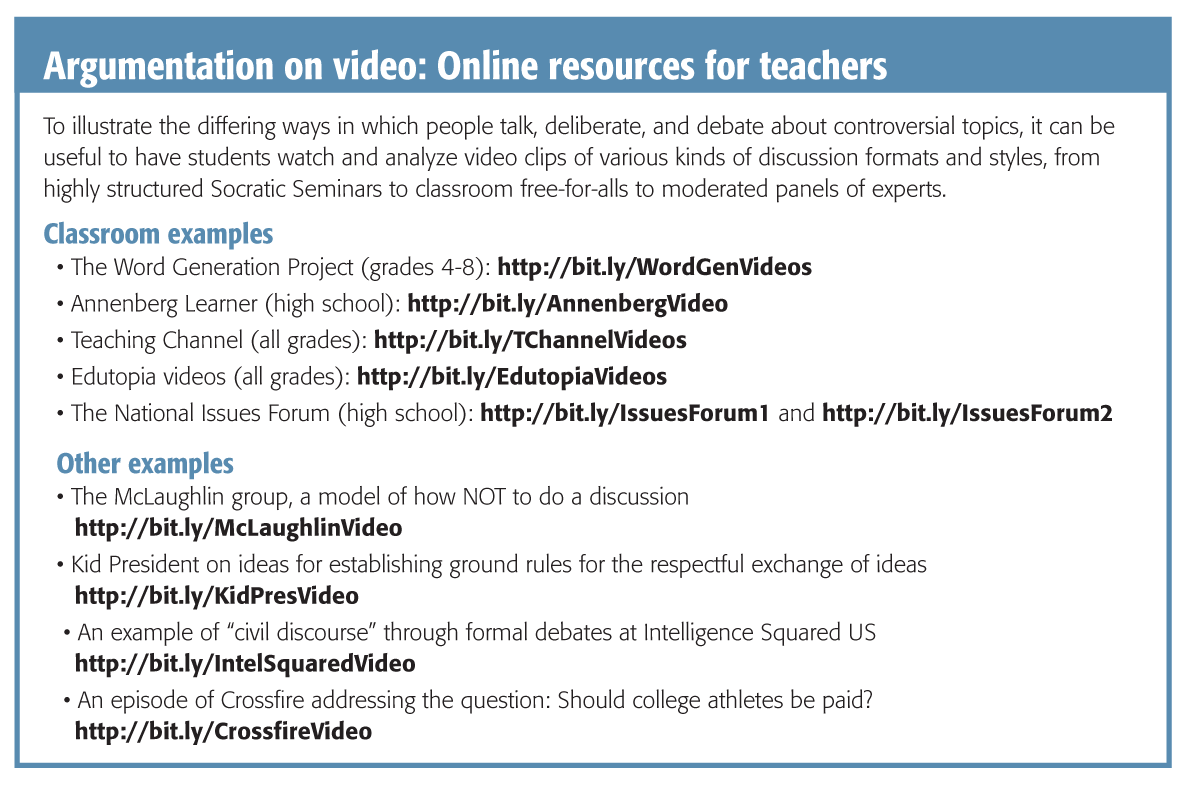A study of classroom deliberations in four high schools shows what can go wrong when teachers neglect to prepare students to argue in a civil manner.
Democracy requires civil discourse in which individuals listen to others, even if they disagree; defend their viewpoints with evidence, reason, or personal experience; recognize valid disagreements; reconsider positions in light of new evidence; and compromise in the interest of the common good (Gastil & Levine, 2005). Unfortunately, the contemporary context of polarized American society reflects significant disregard for civil discourse. Although the United States has long been a “rude democracy” (Herbst, 2008), today’s situation is problematic for the civic mission of the schools and for youth who are at a critical juncture of identity formation, particularly civic identity, in school (Hart & Atkins, 2002; Lannegrand-Willems & Bosma, 2006).
At the same time that adolescents have been bombarded with incivility in the political arena, they have been encouraged to engage more often in civil debate in school. In recent years, for example, argument has been identified as the “core” (Wiggins, 2014) of the Common Core State Standards for English language arts. Argument has been celebrated as an important “path to developing students’ thinking and writing” (e.g., Kuhn, Hemberger, & Khait, 2014, p. 1). And it has been highlighted in the National Council for the Social Studies’ College, Career, and Civic Readiness framework.
Although we do not disagree with this renewed emphasis on the teaching of argumentation, we worry that without a corresponding emphasis on listening and civility, schools may leave young citizens poorly equipped to engage in productive political discourse. In this article — and continuing the conversation about the teaching of controversial topics that began in Kappan’s December 2017/January 2018 issue — we draw on our own research (Crocco et al., 2017) to consider the promises and pitfalls of argumentation in classroom contexts, especially those where contemporary social and political issues are being considered.
Every kind of student-centered instruction requires skillful facilitation. Decades of research on cooperative learning, for example, have shown that teachers can’t afford to presume that students already know how to cooperate. Left to their own devices, students tend to struggle, which leads teachers to abandon the approach, concluding that it doesn’t work (Johnson & Johnson, 1994; Slavin, 1994). The same goes for argumentation. Without explicit support and guidance from the teacher, classroom deliberations tend to become chaotic shouting matches.
Without explicit support and guidance from the teacher, classroom deliberations can become chaotic shouting matches.
But research also shows that when teachers provide appropriate scaffolding, such student-centered approaches are worth the effort. For example, cooperative learning has been found to improve social cohesion, reduce prejudice, elevate the performance of the entire class, and lead students to come up with better solutions to problems than they would have found on their own (Cohen, 1994; Deutsch, 1993). The teaching of argumentation can be just as powerful, we believe, in helping students not only to strengthen their own learning but also to develop the skills for civic engagement. But, as we’ve learned from our research, students cannot reap these benefits without certain support from teachers.
Classroom deliberations of public policy issues
In 2015-16, we studied students’ use of evidence in the context of classroom debates. We draw here on research conducted in four high school classrooms — with four distinct demographic profiles — in which students were assigned to deliberate about two topics: immigration policy and internet security. To prepare for the in-class deliberations, teachers gave students packets that included seven kinds of evidence supporting each side of the issue at hand. Teachers spent one class period introducing the evidence packets and one class period facilitating the deliberations. We observed lively engagement in the deliberations about immigration policy, with students differing widely in their positions. By contrast, students’ positions on internet privacy were so unanimous that the deliberations fell flat. (Almost all students said having search engines and social media track user data was not a big deal to them.)
The observations presented here — based chiefly on the deliberations about immigration policy — are not meant as critiques of the participating students or teachers. Rather, we aim to share what we learned about how students tend to argue in such settings, along with some thoughts about ways to help students make good use of evidence and argue in a civil fashion.
Students tended to use evidence selectively.
Despite being given carefully curated evidence packets, students tended to dismiss this evidence in favor of outside sources. Some of these sources, especially students’ personal stories about immigration, appeared to add valuable information and perspectives to the conversation. However, students also cited a number of outside sources that featured false and unsupported claims (such as inaccurate data about the numbers and percentages of immigrants who have committed crimes). Within the rapid, back-and-forth context of the classroom deliberations, teachers struggled to call out and correct such misinformation, and when they did manage to do so (redirecting students to credible sources), many students simply glossed over the new information and repeated the claims they had already made. In short, students’ use of (and disregard for) the evidence packets demonstrated the same forms of “confirmation bias” — favoring sources that support what one already believes — that have been reported in the political science literature (Nickerson, 1998).
Students tended to use deliberations to justify their own views.
In general, students viewed the deliberations less as an opportunity to learn new skills or understand others’ perspectives than to state and promote their existing viewpoints. As one student declared at the very beginning of a classroom deliberation, “I already had my decision [about immigration policy] before I read it [the evidence packet].” Although not all students were so explicit about their attitudes toward the evidence, our observations suggest that many shared his sentiment.
Similarly, few students seemed to view their peers as resources for learning. By and large, they talked past one another, without truly listening or responding to others’ statements (skills that are often described as fundamental to effective argumentation; Fletcher, 2015). Rather, many students seemed to want only to state their views, win the argument, and assert the superiority of their position. (However, in the classrooms in which deliberation was used more frequently and in the cases in which teachers played an active role in facilitation, we did see somewhat more of an exchange of ideas, which encourages our belief that greater success will come with practice and structure.)
Males tended to dominate deliberations.
Male students contributed more frequently than female students to the deliberations, and the kind of discourse that dominated the deliberations was traditionally masculine in nature (i.e. rationalistic and statistics based, less focused on the relational or affective; Tannen, 1996). When students (most often male) confidently rattled off statistics (whether correct or not), this information was regarded as definitive and was rarely challenged. When other students voiced personal stories or judgments reflecting an ethic of care (Noddings, 1984), male students often countered or dismissed them as irrelevant or less compelling. Gender was especially at play in one classroom, with many of the young women and men lining up on opposite sides of the immigration issue, with the latter group dominating the conversation. The gendered nature of deliberation has been reported in both civic education and political science research (Avery, Levy, & Simmons, 2013; Mendelberg, 2014). Other forms of status such as race and class have also been shown to have an effect on who gets to talk and whose opinions get heard (Hess, 2008).
Teachers varied in their approach to facilitation.
All four teachers took time to set the “rules” for deliberation while still taking different approaches to facilitating. One teacher took a particularly active role in the deliberation, helping students understand the issue at hand, elucidating the issue’s component parts, inviting all students into the deliberation, and using humor to defuse tension. Before the deliberation, he had students pair up, share their position on immigration, and then indicate, by holding up a green or red card, whether they agreed or disagreed with that position. Other teachers intervened less often, trying to avoid interjecting their view or shaping the deliberation’s direction. This approach provided students greater freedom but also led to missed opportunities to clarify misconceptions, ensure students’ points were understood, or refocus students’ attention to the evidence provided.
Teaching civil argumentation: Recommendations
Despite teachers’ efforts to promote productive deliberations in the classrooms we observed, students often engaged in and reinforced behaviors that mirror the incivility plaguing our national politics: talking past one another, using evidence selectively, and valuing being “right” over engaging across differences to build common ground. In response, we offer a set of recommendations for promoting more civil and nuanced forms of argumentation in the classroom:
Establish a classroom community.
Schools provide one of the first and perhaps the best opportunity to help young people build the sense of community that makes it possible for them to deliberate in civil fashion (Flanagan, 2014). Educators should be particularly careful to ensure not just that all students are treated equally but, just as important, that students recognize that they belong to a school community that values fairness and equity. As Flanagan (2014) has advised, teachers and administrators should make it a priority to create — and talk about the value of — a school climate of tolerance, open-mindedness, social trust, and commitment to the common good.
Students viewed the deliberations less as an opportunity to learn new skills or understand others’ perspectives than to state and promote their existing viewpoints.
Ask students to help define the ground rules.
Teachers should invite students to discuss the need to establish ground rules for the respectful exchange of ideas (Crocco, 2007), and they should encourage students to help create those ground rules from the start, building a civil classroom climate through the very process of defining it. For example, we recommend that teachers show video clips of civil and uncivil discussions, pausing them frequently to ask students which behaviors they want to emulate or avoid. (For a similar approach, focusing on students’ reactions to written arguments, see the “interrupted reading” strategy suggested by Fletcher, 2015.) Students can then draw upon these observations to discuss what it means to have a “good” argument and to decide on specific rules for their own participation in classroom deliberations. For instance, they may decide that it is important to practice “engaged listening” (Sherman, 2006), in which participants use active cueing through eye contact, facial expression, body language, and affirming comments to signal that they hear another’s perspective. They might decide that everybody should be required to “listen with an open mind” (Fletcher, 2015), giving time and consideration to new ideas rather than rejecting them out of hand. Or they might decide that all participants should play the “believing game” (Elbow, 1998), making a genuine effort to understand each other’s positions fully before proceeding to question or criticize them.
Select topics carefully.
Teachers should take great care to choose topics and resources that will not only pique students’ interest but also provoke differing responses (as did the topic of immigration policy in the deliberations we studied). To determine whether students have a range of viewpoints on an issue, teachers might conduct a quick straw poll, for example. Further, they can look to web sites such as the National Issues Forum (www.nifi.org), Choices (www.choices.edu), and procon.org, which suggest a wide variety of controversial topics and provide related resources, background materials, and discussion prompts.
Ease slowly into classroom deliberations.
We recommend deliberation “warm-ups,” in which students carefully read background materials, turn and talk with classmates about their initial reactions and questions, and engage in prewriting exercises designed to flesh out their thoughts. Ideally, if the process of learning about the topic is slowed down in this way, then students will be more likely to consider a range of perspectives, evidence, and arguments rather than rushing to take a position and find sources that support it.
Vary the format.
We recommend that teachers experiment with a range of facilitation strategies and discussion formats to show students how such choices can influence how people deliberate. For example, the teacher might ask students to argue using a whispering voice, which will likely force them to listen carefully and refrain from emotional outbursts. Or she might ask students to rephrase the previous point before offering their own or to use scripted phrases to build a connected conversation, such as “I see your point, but I wonder . . .” or “That makes sense to me, but I have concerns that . . .”
Go beyond pro and con.
In the deliberations that we observed, some of the most sophisticated thinking came from undecided students who could articulate defensible positions on both sides of the issue. Students should have opportunities not just to argue from a fixed perspective but also to experience what it is like to seek common ground. The goal of any deliberation is to decide on a course of action. However, students should recognize that they have the option to try on many perspectives before deciding which action to take. Further, they should understand that sometimes the wisest option is to adopt a compromise position, one that most students in the room see as valid, even if it is not wholly representative of their personal viewpoints, and where even those who’ve lost the argument feel that their views have been given a fair hearing.
Be an active facilitator.
Teachers should be ready and willing to intervene in classroom deliberations, not to express their own opinions but to remind students to follow their own rules of discussion, help them defuse tensions, call attention to factual misunderstandings, and, especially, to make sure that competing perspectives are offered and heard. We suggest that teachers structure the process so interruptions are minimized, reasonable positions are not dismissed out of hand, and all students — whatever their race, class, gender, religion, or first language — have equal opportunities to contribute their ideas and have them taken seriously.

A participatory process
The current emphasis on argumentation in K-12 education, though useful, may inadvertently contribute to the development of skills that promote, rather than alleviate, incivility. If schools are to achieve their civic potential, then the teaching of argument will need to be balanced with an emphasis on listening and understanding. Our hope is that teachers will develop their own strategies for fostering classroom communities in which respecting others’ perspectives, reconsidering one’s own stance, and asking thoughtful questions have more value than winning the debate.
We are not suggesting that if K-12 educators do more to promote civility and listening, this will ease the current trend toward political polarization or cause large numbers of Americans to become more open to new ideas. What educators can accomplish, however, is to help many more students learn and practice those skills that allow for the civil exchange of ideas, the expression of mutual understanding, and potentially, over the long haul, the ability to see legitimacy in policy decisions that one did not support.
As the political theorist Benjamin Barber (1989, p. 356) once wrote:
The participatory process . . . that characterizes strong democracy attempts to balance adversary politics by nourishing the art of listening. “I will listen” means to the strong democrat not that I will scan my adversary’s position for weaknesses and potential trade-offs, nor even that I will tolerantly permit him to say whatever he chooses. It means, rather, “I will put myself in his place, I will try to understand, I will strain to hear what makes us alike.”
These words are perhaps even more true in 2018 than when they were first written in 1989. The United States may be a “rude democracy,” but its classrooms and schools need not be.
References
Avery, P., Levy, A., & Simmons, A. (2013). Deliberating controversial public issues as part of civic education. The Social Studies, 104 (3), 105-114.
Barber, B. (1989). Public talk and civic action: Education for participation in a strong democracy. Social Education, 53 (6), 355-370.
Cohen, E. (1994). Designing group work. New York, NY: Teachers College Press.
Crocco, M.S. (2007). Teaching The Levees: A curriculum for democratic dialogue and civic engagement. New York, NY: Teachers College Press.
Crocco, M., Halvorsen, A., Jacobsen, R., & Segall, A. (2017). Teaching with evidence. Phi Delta Kappan, 98 (7), 67-71.
Deutsch, M. (1993). Educating for a peaceful world. American Psychologist, 48 (5), 510-517.
Elbow, P. (1998). Writing without teachers (2nd ed.). New York, NY: Oxford University Press.
Flanagan, C. (2014). Teaching a larger “sense of community.” Analyses of Social Issues and Public Policy, 14 (1), 423-425.
Fletcher, J. (2015). Teaching arguments: Rhetorical comprehension, critique, and response. York, ME: Stenhouse.
Gastil, J. & Levine, P. (2005). The deliberative democracy handbook. San Francisco, CA: Jossey Bass.
Hart, D. & Atkins, R. (2002). Civic competence in urban youth. Applied Developmental Science, 6 (4), 227-236.
Herbst, S. (2008). Rude democracy. Philadelphia, PA: Temple University Press.
Hess, D. (2008). Controversy in the classroom. New York, NY: Routledge.
Johnson, D.W. & Johnson, R.T. (1994). Cooperative learning in the classroom. Alexandria, VA: ASCD.
Kuhn, D., Hemberger, L., & Khait, V. (2014). Argue with me. Bronxville, NY: Wessex.
Lannegrand-Willems, L. & Bosma, H.A. (2006). Identity development-in-context: The school as an important context for identity development. Identity, 6 (1), 85-113.
Mendelberg, T. (2014). The silent sex: Gender, deliberation, and institutions. Princeton, NJ: Princeton University Press.
Nickerson, R.S. (1998). Confirmation bias: A ubiquitous phenomenon in many guises. Review of General Psychology, 2 (2), 175.
Noddings, N. (1984). Caring. Berkeley, CA: University of California Press.
Sherman, S. (2006). Moral dispositions in teacher education: Making them matter. Teacher Education Quarterly, 33 (4), 41-57.
Slavin, R. (1994). Cooperative learning: Theory, research, and practice (2nd ed.). New York, NY: Pearson.
Tannen, D. (1996). Gender and discourse. New York, NY: Oxford University Press.
Wiggins, G. (2014, October 23). Argument — the core of the Common Core — and a clarifying example. Blog post. https://grantwiggins.wordpress.com/2014/10/23/argument-the-core-of-the-common-core-and-a-clarifying-example
Originally published in February 2018 Phi Delta Kappan 99 (5), 4. © 2018 Phi Delta Kappa International. All rights reserved.
ABOUT THE AUTHORS

Anne-Lise Halvorsen
ANNE-LISE HALVORSEN is an associate professor in the Department of Teacher Education at Michigan State University, East Lansing, Mich.

Avner Segall
AVNER SEGALL is a professor in the Department of Teacher Education at Michigan State University, East Lansing, Mich.

Margaret Crocco
MARGARET CROCCO is a professor and chairperson of the Department of Teacher Education at Michigan State University, East Lansing, Mich.

Rebecca Jacobsen
REBECCA JACOBSEN is an associate professor in the Department of Educational Administration at Michigan State University, East Lansing, Mich.










